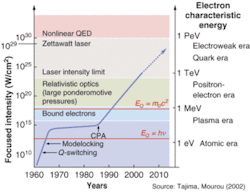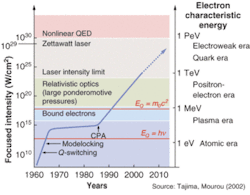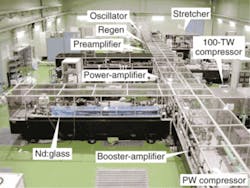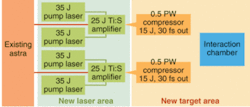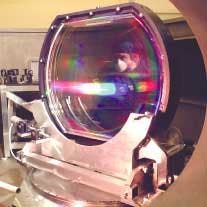Petawatt lasers aim for relativistic phenomena
Big pump lasers, adaptive custom laser systems, OPCPA, and innovative gain- media strategies play leapfrog en route to higher powers and faster rep rates.
It was not very long ago that a terawatt (TW; 1012 W) lLaser was considered an impressive achievement. Now a 100-TW laser is commercially available, but the largest lasers are still only at large research institutions. Some of these systems are Ti:sapphire-based and some are glass-based. Some systems are entirely based on OPCPA (optical-parametric chirped-pulse amplification). Researchers in Jena, Germany, are even developing a diode-pumped system. Ti:sapphire lasers have always been limited by the amount of pump light available. However, technology is allowing for very large pump lasers and, thus, lasers are approaching the petawatt (PW; 1015 W) class. Representatives from many of these laser centers shared results and ideas last October at the first International Conference on Ultrahigh Intensity Lasers (ICUIL) in Lake Tahoe, CA.
FIGURE 1. Chirped-pulse amplification (CPA) has enabled the focused intensity of tabletop laser systems to climb about eight orders of magnitude from about 10 15 W/cm 2 to the range of 10 18 W/cm 2, corresponding to a power increase from gigawatt to petawatt class, and enabling entirely new regimes of high-field science (solid portion of curve). Further increases in power and laser intensity (dotted portion of curve) will exceed the capabilities of tabletop systems, however. 1
The motivation for all of this activity lies in the study of relativistic laser-plasma interactions. Prior to the introduction of chirped-pulse amplification (CPA) by Gerard Mourou’s group in the late 1980s, the inability to amplify ultrashort pulses without optical-component damage due to unwanted nonlinear effects placed a limit of about 1015 W/cm2 on focused laser intensities (see Fig. 1). Chirped-pulse amplification essentially removed this limitation, enabling focused intensities to climb above 1018 W/cm2 and effectively launching high-field science beyond the limits of atomic phenomena and into the realms of plasma and positron-electron phenomena.1
Ti:sapphire tabletop petawatts
In addition to enabling unprecedented powers in big glass lasers, such as the first petawatt shot at Lawrence Livermore National Laboratory (LLNL; Livermore, CA) in 1996, the CPA principle has also enabled tabletop systems at universities to climb through gigawatt and terawatt power levels to actually achieve petawatt class. Existing laboratory-sized petawatt lasers are Ti:sapphire systems because Ti:sapphire has a much higher gain bandwidth than glass and therefore offers much narrower pulse widths. Compared to Ti:sapphire, glass lasers require a lot of energy and very large gratings. Glass lasers are also more expensive, and because glass has poor thermal conductivity, pulse repetition rates are limited by the risk of breaking the glass rods. Some of this is changing, but Ti:sapphire remains the dominant technology for laboratory-sized PW laser efforts. The name of the game with Ti:sapphire is how to get enough green light to pump with. The answer appears to be: pump with glass.
The first successful laboratory-sized petawatt laser demonstration took place at the Advanced Photonics Research Center in the Japan Atomic Energy Research Institute (JAERI; Kashiwa, Japan).2 The JAERI researchers achieved 100 TW in 1995 and hit 0.85 PW in 2002 using a four-stage Ti:sapphire CPA system that is now using a large glass laser (emitting 70 J of green light) for pumping the final amplifier stage. One important contribution by this group was solving the problem of amplified spontaneous emission (ASE) inside the relatively large crystals required for these systems (three to four inches of gain length in the transverse dimension). The JAERI researchers solved the problem by wrapping the crystal in high-index plastic. They have achieved focused intensity on the order of 2.6 × 1019 W/cm2 and pulse repetition rates on the order of one shot every few tens of minutes (see Fig. 2).
The Hercules laser at the University of Michigan (Ann Arbor, MI) also produces 0.85 PW at the relatively high repetition rate of one shot every 10 seconds, making it the fastest and most powerful Ti:sapphire system in the world. The Nd:glass pump uses four 15-J green pump lasers, each containing two 16-mm heads producing 7.5 J apiece. The Michigan researchers have achieved intensities on the order of 0.8 × 1022 W/cm2 using a deformable mirror and wavefront sensor to achieve a single-wavelength spot size.3
The adaptive custom laser systems approach delivers a high level of shot-to-shot beam uniformity because wavefront fluctuations ultimately limit the focused intensity and its spatial resolution. The shot-to-shot wavefront fluctuation on Hercules has a root-mean-square deviation from average on the order of λ/20.2 Interestingly, a drawback to achieving such good beam quality in such a small focal region is that the interaction region of high intensity is becoming so small that there is not enough volume to include a significant amount of target matter to interact with.
The Central Laser Facility at the Rutherford Appleton Laboratory (Oxfordshire, England) has a large Ti:sapphire facility called the Astra laser that will be used as a seed for the ongoing Astra Gemini Project, which seeks to exceed the current 0.85‑PW high mark by bringing two 0.5‑PW beams online in 2007.4 Each beam will be independently configurable and focusable to intensities on the order of 1022 W/cm2 in a system that would be capable of firing once every minute. The current performance of the 800-nm Astra laser yields 40‑fs-duration pulses at energies up to 500 mJ and focused intensities up to 1019 W/cm2. It is pumped by a custom-built 5-J Nd:YAG power-amplifier pump laser delivering 30-ns pulses in two 532-nm beams at a repetition rate of 10 Hz.
Each of the twin Ti:sapphire amplifiers for the Astra Gemini will be pumped by two 45-mm-diameter Nd:glass lasers, each producing 35-J, 10-ns optical pulses at repetition rate of once per minute (see Fig. 3). Each pair of pumps will operate simultaneously to send 70-J pulses to the 70-mm-diameter Ti:sapphire amplifier that will be seeded by the existing Astra laser. The two resulting 25- to 30-J beams will propagate through vacuum spatial filters to two compressors to provide two 15-J, 30-fs, 0.5-PW pulses. And off-axis parabolic focusing will yield optical intensities on the order of 1022 W/cm2 from each beam. Other particularly notable Ti:sapphire laser projects include the Laboratoire d’Optique Appliquée (LOA) laser (Palaiseau, France), which is rapidly approaching petawatt class, and the Advanced Photonics Research Institute (APRI) laser (Gwangju, Korea), currently at 25 TW and on a five-year timeline to achieve 1 PW.
OPCPA petawatts in glass
The Rutherford Appleton Laboratory is also the home of the PW-class Vulcan laser, which actually belongs to a larger class of laser systems geared to produce PW powers through the use of CPA in glass. These systems start out with a short-pulse source, typically a modelocked Ti:sapphire oscillator. The pulses from this oscillator are then amplified in various ways. The most common of these is either a regenerative amplifier or OPCPA. Regenerative amplifiers (regens) have been in use for a long time but have some undesirable side effects. Since the gain material is an energy storage device, the system produces ASE. Also, the multiple surfaces in the regen result in spurious pre-pulses. There is also the problem of gain narrowing of the input spectrum. Ti:sapphire has low gain at 1054 nm and so pulls very hard to the blue.
In the case of OPCPA, nonlinear crystals are pumped by special pump lasers in the green so as to mix the short-pulse wide bandwidth of the seeder as a signal. Because the amplified signal is close to the degeneracy of the pump, large amplified bandwidths are obtained, resulting in shorter pulses after compression. Another benefit of this process is that the nonlinear material does not store energy, so amplification only occurs when both the signal and pump are present, thus removing any pre-pulses. Furthermore, any problems with the pump beam translate into distortions in the idler beam, leaving the signal beam as it was before amplification.
The Vulcan, with the assistance of an upgraded OPCPA front end, produced a 1.03-PW, 423-J, 410-fs pulse, focused onto its intended target with an intensity of 1.06 × 1021 W/cm2 in October of 2002 and actually made the Guinness Book of World Records in 2004 and 2005 as the world’s most powerful laser (see Fig. 4). Henry Hutchinson discussed this system at the ICUIL meeting. The OPCPA preamplifier is pumped by a commercial custom-designed Q-switched Nd:YAG, single-longitudinal-mode laser that generates a train of Gaussian,1‑J, 15-ns pulses at 10 Hz and 532-nm wavelength. The Vulcan has also been upgraded with a very large compressor stage and amplifiers from the NOVA laser, which operated from 1984 to 1998 at LLNL and, in 1996, became the first laser to break the PW power barrier, hitting a 1.25-PW peak.
Recently, John Collier attempted to achieve a PW using only the OPCPA technique in three stages pumped by the Vulcan laser. Using only 80 mm of crystal, 0.4 PW was achieved. Because of time constraints due to the busy Vulcan schedule, this result was demonstrated with only 1% of the beam in a compressor in air. It has been shown that with suitable pump lasers, as can be found in the arms of large fusion-research laser systems, such as the National Ignition Facility (NIF) at LLNL or the French Atomic Energy Commission’s Laser MégaJoule (Bordeaux, France), as much as 100 PW can be achieved. Numerous other groups are working on the same idea.
Another huge glass system, the OMEGA laser, at the Laboratory for Laser Energetics (LLE; Rochester, NY), is currently in the design and procurement phases for an extended-performance upgrade. According to a presentation by Cristian Stoeckle at the ICUIL, the extended-performance system will mirror all of the other legs of the OMEGA laser in two arms. The front end of this system will be OPCPA. And the OPCPA pump laser will have a shaped pulse to produce a very high-quality flattop profile in both space and time. The main amplifier is made of a ring with 1‑in Nd:YLF heads.
There is also an ongoing development effort for a couple of lines at the NIF to produce short pulses, with a goal of 10 kJ in 50 ps, according to an ICUIL presentation by Ed Moses. The NIF researchers have developed a novel four-grating stretcher grating design that allows for a much smaller compressor. In these very-high-energy systems, a very large compressor grating is required. The LLNL group has made a grating 80‑cm long. At this point in time, making bigger gratings seems to be the limiting factor in making bigger lasers.
The solution being pursued today is to take several small gratings, much easier to produce and field, and tile them next to each other to make a large grating. All of the mechanical properties of the gratings, including their orientation in space, need to be aligned exactly. The LLE demonstrated a closed-loop system that can accomplish this. LLNL devised a very clever scheme to measure grating orientations by inspecting the grating interface out of the main beam path, which is very important, given the restricted space in the vacuum compressors.
REFERENCES
1. T. Tajima and G. Mourou, Phys. Rev. Spec. Topics-Accelerators and Beams 5(031301) 1 (2002).
2. wwwapr.apr.jaeri.go.jp/aprc/e/index_e.html
3. www.eecs.umich.edu/CUOS/HERCULES/index
4. www.clf.rl.ac.uk
JAMES NORBYis the custom laser product manager at Continuum, 3150 Central Expressway, Santa Clara, CA 95051; e-mail: [email protected].
